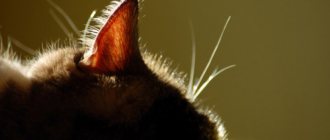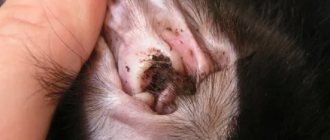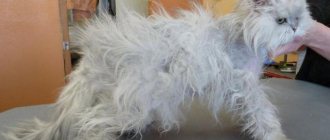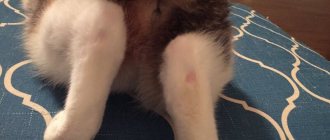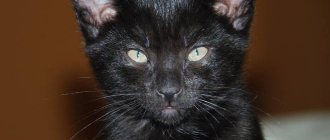Why does a cat go bald: reasons
Baldness (alopecia) leads to the appearance of bare patches of skin on your pet's body.
If there is too much hair, bald spots appear, the animal behaves restlessly
The main reasons for the development of pathology:
- allergic reaction;
- damage by fleas, lice;
- the presence of a scabies parasite;
- otodectosis (ear mites);
- fungal or lichen infections (dermatomycosis, dermatophytosis);
- pyoderma;
- purulent formations on the skin;
- oily seborrhea;
- deficiency or excess of thyroid hormones;
- increased work of the adrenal glands;
- diabetes;
- genetic predisposition;
- stress;
- lack of vitamins;
- chronic diseases of internal organs.
Important! A common cause of alopecia is food allergies. It is not recommended to give pets food from the human table. Veterinarians advise buying specialized food that contains the necessary vitamins and minerals.
Healthy coat and lack thereof
The second name for baldness is alopecia. The pathology is manifested by abundant hair loss of the pet, the formation of bare areas - bald spots. In a healthy state, cat fur is soft, shiny, silky, and the hairs fit tightly together.
Cats have fur replacement year-round. During certain periods, the shedding of hairs increases and the density of the fur decreases significantly - this is molting. If the shedding cat’s health is normal, there are no pathological formations on the skin, the nose is moist and cold, and the appetite is good, then there is no reason to worry.
Lack of hair can be congenital and not associated with pathology. The peculiarity is detected from 4 months of age and cannot be treated.
By origin, alopecia is:
- symptomatic – associated with a specific pathology;
- idiopathic - an independent disease.
The source of baldness varies:
- diffuse – the fur comes out abundantly and evenly;
- localized – a certain area of the skin goes bald;
- partial – bald spots appear in different places.
When a cat tears at itchy skin with its claws, infection can enter the wounds and an inflammatory process will begin.
Common types of hair loss in cats
An analysis of the location of bald spots on the cat’s body and the condition of the skin helps to make a rough diagnosis.
| pathology | symptoms |
| dermatological diseases | uniform baldness of the trunk and limbs |
| hormonal imbalances | the cat's tail at the base, chest, nose, hips goes bald, the skin becomes inelastic |
| thyroid pathology | fur grows abundantly on the neck, chest, belly, and pelvic area |
| stress | the cat begins to itch intensely, the back, inner thighs, belly, limbs, and anus go bald |
| avitaminosis | the body begins to become covered with medium-sized naked spots of a round shape, usually merging, the skin in the lesions turns red |
| oncological pathologies | large bald spots cover the lower body, belly, limbs, complete loss of hair is possible |
| fungal infection | In bald areas, cracking and peeling of the skin is observed |
Symptoms of hair loss in cats
A healthy cat should have soft and silky fur.
Partial alopecia on the back of a cat
Severe hair loss requires treatment. Alopecia usually begins to manifest itself with the appearance of bald spots on a cat in one area of the body, and other areas of baldness gradually appear.
The skin at the site of loss may be rough and red with small wounds. If the area of a cat’s bald spot is painful or itchy, the animal reacts aggressively to touch.
Treating a cat for parasites
Treatment must be prescribed by a doctor. Most often, complex spot-on preparations (pipettes with medicine on the skin) are prescribed in an intensive mode - every 10-14 days. The most commonly used are “Stronghold” and “Inspector”. In case of skin infection, the doctor will prescribe local treatments with antiseptic solutions and even antibiotics. Recently, information has appeared about the effectiveness of the Bravecto tablet used in dogs in cats. Studies have already been conducted and safe doses for cats have been determined. However, there is no information in the instructions yet, but it will probably appear very soon.
Diagnosis of alopecia in different parts of the body
Only a doctor can determine why a cat is going bald. The basis of diagnosis includes medical history, visual examination, and microscopic examination of hair roots.
Be sure to read:
Why does a cat constantly scratch its chin: what kind of disease is it?
The pet's blood is examined and a scraping is taken from the skin. If a tumor is suspected, an x-ray or ultrasound is performed.
The diagnosis is partially helped by the localization of bald spots on a cat:
- Symmetrical baldness of the abdomen, thighs, sides, and front legs is a characteristic symptom of a skin disease.
- Due to stress, cats tear out hairs in the anus , on the back, paws, stomach, and inner thighs. This happens especially often in the following breeds: Siamese, Abyssinian, Himalayan.
- Hormonal disorders are usually indicated by alopecia on the bridge of the nose , base of the tail, hips, and chest. The skin ceases to be elastic.
- In the case of a lack of thyroid hormones, pet hair is easily pulled out in the pelvic area , on the stomach, chest and neck.
- Cancerous formations provoke bald spots on the stomach, chest, and paws . Oncology can cause complete hair loss.
- Vitamin deficiency is characterized by the appearance of small, round bald patches, which can unite. The skin in places where there is no fur is bright pink.
- Fungal infections are characterized by the appearance of bald spots with scaly, cracked skin.
Scratching a pet's skin is dangerous due to infection and the development of an inflammatory process.
To make it easier for you to determine the cause of your pet's baldness, we have prepared a table. It contains all the main pathologies accompanied by hair loss in a cat:
Types of alopecia
In veterinary medicine and medicine, the term “alopecia” is used, which means pathological thinning or complete loss of hair in a certain area of a cat’s body.
There are 2 forms of the disease, which can be classified according to the location of the bald patches:
- Diffuse or generalized alopecia is profuse hair loss throughout the body, which leads to significant thinning of the hairline.
- Zonal (focal) alopecia - when hair comes out on a certain area of the body (head, paw, neck, tail).
Alopecia can also be:
- self-induced (self-induced);
- spontaneous (against the background of calcium, zinc and iron deficiency in the cat’s body);
- parasitic (fleas, subcutaneous mites);
- genetic;
- post-traumatic, postoperative.
Self-induced (self-induced)
This type of alopecia is quite common among decorative cat breeds living in apartments. Out of boredom, stress, or for other reasons, the cat begins to lick itself frequently, stopping at certain areas of the body. As a result, the fur becomes thinner and falls out, and constant exposure to the cat's rough tongue prevents the growth of new undercoat. From the outside it looks like a hairless pink spot without injuries or sores. It takes a long time to deal with the problem.
The best and proven methods:
- Purchase a cat diffuser or spray to diffuse pheromones or essential oils. For example, Feliway (pheromones stabilize the cat’s emotional background and reduce unusual forms of stressful behavior) or Relaxivet (lavender, rosemary and geranium oils relieve nervous tension and anxiety).
- Eliminate the cause of stress (get a second cat, fish, buy new toys, a scratching post house, build loopholes or tunnels for exciting leisure time for kittens in the absence of their owners). This will distract your pet from its excessive hygiene.
Sometimes a cat independently licks one area of the body where it feels pain, itching, or burning. This usually occurs after injections into the withers, vaccinations, when applying bandages or the formation of a tumor.
If the cause of anxiety is eliminated, the animal will calm down. You can resort to using a protective collar, which is sold at a pet store.
Independent (spontaneous)
This type of baldness in cats is the most unpredictable and mysterious, because it appears spontaneously and for no particular reason. The fur falls out and does not grow back. Diagnosis is carried out with the participation of a veterinarian in the clinic, who will clarify the following information from the animal owner:
- What is the diet and have there been any changes in the cat’s diet recently? A sudden change in food can cause thinning of the coat (especially if there is food intolerance or the new food is of poorer quality).
- What medications does your pet take and what is it being treated for? Taking some medications can cause your cat's fur to fall out in clumps. Once treatment is complete, the hair will grow back.
- Have you had contact with other animals? This may be the cause of the development of parasitic diseases on the skin.
- What operations did the cat undergo? There may be no fur at the suture site for a long time.
- Whether there were matings, births (lactation period and kittens) and when.
- Did the cat fall from a height or receive other injuries (strong impacts provoke irreversible processes on the skin).
Important! Only after a complete history has been collected and a series of laboratory tests have been carried out, will the veterinarian be able to determine the cause of the disease and diagnose the cat.
How to treat baldness, what to do, how to help at home?
Therapy for the disease is aimed at eliminating the causes of alopecia:
- For allergies, contact with the allergen is eliminated, the use of anti-allergy drugs, immunostimulants, and diet are effective.
- For parasitic lesions, shampoo, ointment, and spray are prescribed.
- Pyoderma and abscesses are eliminated by excision of the affected skin, antibiotics and antiseptics are used to treat wounds.
- Stressful conditions are corrected by taking sedatives.
- Malfunctions of the thyroid gland are treated with hormonal medications; if a tumor develops, surgery is prescribed.
- Bacterial folliculitis is treated with antibiotics, usually amoxicillin. The pet is washed with medicated shampoo.
- For ringworm, the hair needs to be cut, Ketoconazole, Itraconazole, Griseofulvin are taken orally.
Important! Bald spots in cats caused by hereditary causes cannot be treated.
Treatment depending on the cause
Treatment for alopecia becomes effective once its causes are correctly identified. It will be possible to establish the pathological factors that caused the disorder only after a detailed diagnosis.
If the cat begins to go bald, you will need to decide what to do together with your veterinarian. Before prescribing a course of treatment, the doctor will conduct a thorough examination of the pet and conduct a conversation with its owners. The following diagnostic methods will help you make a correct diagnosis:
- taking hair roots from the patient for subsequent examination under a microscope;
- general blood test;
- scraping from affected areas of the body;
- ultrasound or x-ray examination of internal organs (if the cat is suspected of having tumors).
The subsequent fight against the disorder is aimed at eliminating the underlying disease that provoked the thinning of the coat.
Treatment for a cat that is going bald is not quick and takes a considerable period of time. For successful hair restoration, all procedures must be done in accordance with the recommendations of a veterinarian. If the process is started, it is quite difficult to return the animal to normal coat.
What to do about baldness caused by infections
If the infectious nature of the disorder is confirmed, cats are prescribed:
- antiviral drugs (Kanamycin, Ribaflox);
- antibiotics (Amoxicillin, Ceftriaxone).
When affected by the fungus that causes ringworm, a combination of topical and internal agents is necessary. Sanoderm ointment, Mycostop ProVET spray, Orungal tablets, Ketoconazole are indicated for animals.
For cheyletiellosis, the main emphasis is on the use of skin preparations. It is possible to destroy parasites that cause thinning of the coat with the help of Ivermek spray, Demos, Butox.
In addition to the main treatment, you will need to enrich the cat’s menu with vitamins and bathe your pet often. Cat dishes and accessories and all rooms must be thoroughly sanitized. When affected by parasites, animals are cut short.
Combating allergies and hormonal problems
First of all, in case of baldness of allergic origin, all irritants must be identified and eliminated. Animals are prescribed anti-allergenic drugs:
- antihistamines;
- steroids;
- preparations with vitamin B 7.
The problem of a hormonal nature is eliminated with hormone-containing drugs. If a cat is going bald due to tumors in the thyroid gland, surgical intervention is prescribed.
The cat's diet includes lean boiled meat, fish, quail eggs, cereals, and vegetables. To prevent infection by parasites or food poisoning, you should carefully handle food and ensure its freshness.
What to do when your cat goes bald from stress
Cats that are going bald due to increased anxiety are prescribed sedatives. It is possible to improve the emotional background thanks to the following drugs:
- "Stop the stress."
- Relax Plus.
- "Zoomir Antistress".
- Fitex.
It will be necessary to normalize the situation in the house, to eliminate factors that traumatize the sensitive psyche of the animal. The cat needs to be provided with toys and places where it could hide in case of fear or stress.
It is important for cat owners to know what to do to prevent alopecia. Prevention of pathology includes a balanced diet of animals, vaccination, and periodic use of antiparasitic agents. Careful hygiene of cats, a favorable psychological climate in the house, and no contact with sick individuals are required.
Baldness in cats, how to deal with shedding: advice from a veterinarian
Seasonal shedding is normal. This period is especially noticeable for owners of long-haired pets. Molting can last from 2 weeks to 3 months. Veterinarians advise washing and combing animals more often during this time.
Be sure to read:
Sores on a cat’s neck that itch and hair fall out: normal or pathological, reasons, what to do
Effective shampoos against hair loss:
- "Phytoelite" from "Veda";
- SynergyLabs Shed-X Cat;
- Perfect Coat 8 in 1.
It is useful to take vitamin complexes, preferably in liquid form.
Bald spots in cats caused by hereditary causes cannot be treated.
To remove hair from the stomach, it is recommended to give special medications:
- Pet Naturals of Vermont;
- Actipet;
- Vaseline oil, etc.
Ordinary grass can help get rid of lumps; in the summer, it is enough for the animal to go for a walk; in winter, the seeds can be purchased at pet stores and planted yourself.
If shedding is accompanied by specific signs, it is necessary to show the cat to a doctor.
Stress
Stress in cats can manifest itself in a number of ways, one of which is hair loss. Cats that are stressed may begin to scratch or lick their fur compulsively. This is called psychogenic alopecia.
Can cats get bald spots from stress?
Yes, excessive licking due to psychogenic alopecia can cause bald spots. This disease is most common in purebred cats, although these are not the only cats that can be affected.
If you suspect stress is causing your cat's hair loss, you can try environmental changes to relieve her stress. These changes may include separating your cat from other pets that may contribute to stress, providing extra attention, or installing a cat tree to give her a safe place to retreat.
Some cats may also require medications to reduce stress and anxiety. If you think this is the case, talk to your veterinarian to get his thoughts and recommendations.
Preventing hair loss in cats
To protect your pet from the unpleasant symptoms of hair loss, owners need to follow several rules:
- Provide your cat with a balanced diet.
- Avoid factors that provoke stress.
- Vaccinate against infectious diseases on time.
- Avoid contact between a healthy animal and a sick one.
- Treat wool promptly when parasites appear.
- Carry out preventive examinations regularly.
Cancer
Although it is quite rare, cancer may be the cause of your cat's hair loss. Paraneoplastic alopecia in cats may be a sign of pancreatic cancer. Cats with this condition may shed, scratch, or groom themselves more often.
It is also possible that you will notice cracks in your cat's paw pads. Weight loss and decreased appetite are also symptoms to watch for in cats with feline paraneoplastic alopecia. If you notice any of these symptoms, you should schedule a visit with your veterinarian right away.
Lice and fleas
Lice and fleas are small insects that feed on blood and the top layer of skin. If the case is advanced, it is impossible not to notice them on the pet. Favorite localization is around the tail and head.
At an early stage, an accumulation of a black substance, a waste product of fleas, is noticeable. Also, the pet experiences itching, hair loss, redness of the skin, and the formation of wounds.
Lice are eliminated using a special shampoo. Fleas are removed by treating things with which the pet comes into contact with anti-flea agents, carriers, bedding, and all carpets in the house.
Cat worm disease
Worms or helminthic diseases are most common among cats. Owners of their pets should clearly understand that helminthic diseases can occur even if your pets have not left your apartment. They can become infected with existing parasitic worms through eggs of various helminth infections brought from the street on the soles of their shoes. Cats during walks, in close contact with the environment, expose themselves to the danger of becoming infected with helminth eggs, which are found in large numbers on various objects. A particularly great danger in this regard is provided by the direct contact of your cat with other homeless, stray animals. Being essentially predators, cats never refuse raw fish or meat offered to them, which in our time of market relations can be infected with helminthic infestation. Some types of worms cause characteristic, pronounced symptoms of helminthic disease. With severe infestation, the cat loses a lot of weight, even with a good appetite. A sick cat vomits (vomiting in cats), sometimes with blood, and gastrointestinal tract disorder (diarrhea) appears (diarrhea in cats). Kittens infected in utero may die from blockage or rupture of the small intestine. In young cats we note anemia and gastrointestinal disorders. Other worms, hiding in the muscles or liver of a cat for a long period of time, do not show themselves in any way. Taking into account the above, cat owners need to carry out preventive deworming with anthelmintic drugs. For more information about worms, see our article - worms in cats.
Cat affected by ectoparasites. Very often, our cats suffer from diseases that are caused by various parasites that live both outside and inside the animal’s body. Ectoparasites—fleas, lice, and ticks—settle on the skin of cats.
Fleas are wingless insects with a body flattened on the sides. Only adult individuals parasitize the body of cats; the larvae live in the environment. Fleas are extremely prolific - each female lays 25 eggs daily, which fall down, accumulating on the litter, in the cracks of wooden floors, on carpets, etc. After hatching from the eggs, the larvae, after going through a series of changes, turn into adults, which, when they meet a cat, settle in her fur and switch to a parasitic lifestyle. They bite him and drink his blood; as a result of severe flea infestation, the cat loses weight. The presence of fleas in an animal can be indicated by the presence of small black crumbs on the cat’s body.
Oncological diseases. Like other types of domestic animals, cats are prone to cancer. Moreover, the majority of neoplasms identified in cats are malignant in nature, so this pathology requires complex treatment in a modern veterinary clinic by an experienced veterinary specialist.
A malignant tumor in a cat occurs as a result of a malfunction of DNA molecules, which are a repository of information and are present in every cell of the cat.
A malignant tumor, as it grows, increases in size and begins to grow into the healthy tissue of the affected organs, causing inhibition of their function.
The clinical picture of cancer in a cat depends on the organ affected by cancer, the stage of the disease and the general condition of the cat. For many years, the neoplasm in a cat cannot be externally manifested in any way. Symptoms of the disease in an animal may be vague and unclear.
In cases of liver cancer, veterinary specialists note general weakness, fatigue, decreased appetite in a cat, a change in the consistency and color of feces, and a sharp decrease in weight. The cat begins to develop jaundice (visible mucous membranes, the cornea of the eyes and the skin acquire a yellowish tint). Disease symptoms characteristic of liver disease in cats appear.
Stomach cancer in cats. During a clinical examination, the veterinarian notes that the cat has general weakness, drowsiness, poor appetite, and a painful abdomen on palpation. Increased body temperature. There is a change in the color and consistency of fecal matter, sometimes we find blood clots in the fecal matter, the cat suddenly loses weight, and anemia develops.
Bowel cancer. During a clinical examination, a veterinarian finds the same clinical signs in a sick cat as for stomach cancer. Unlike stomach cancer, fresh, scarlet blood appears in the stool, a foul odor emanates from the feces, and bloating occurs. A fetid odor is felt from the oral cavity, and rumbling sounds are heard on auscultation of the intestines. Depending on the affected part of the intestine, there may be diarrhea (diarrhea in a cat) or, on the contrary, constipation (constipation in a cat (coprostasis).
For more information about oncological diseases in cats, see our article - oncology in cats.
Infectious diseases
Infectious diseases in cats are caused by a variety of bacteria and viruses, in which the animal’s body experiences loss of body weight (weight loss) due to loss of appetite and disorders of the gastrointestinal tract. The most common infectious diseases of cats include - (infectious rhinotracheitis in cats, chlamydia in cats, mycoplasmosis in cats, bordetellosis in cats, calcivirus infection in cats, panleukopenia in cats, infectious peritonitis in cats).
Internal non-communicable diseases
Almost all diseases accompanied by loss of appetite and even the entry of a foreign object into the stomach can lead to weight loss.
Common internal non-contagious diseases in cats include:
Kidney stones in cats or urolithiasis is a chronic disease of cats in which stones and urinary sand (urolithiasis) form in the urinary tract of animals. Urolithiasis (UCD) is a chronic disease associated with metabolic disorders and accompanied in a cat by the formation and deposition of urinary stones, different in chemical composition, or sand in the renal pelvis, urinary ducts, bladder, urethra and leading to disruption of natural outflow urine.
Symptoms of the disease. If a cat’s kidney stones are small and there is no blockage in the urinary tract, then the cat’s disease occurs without obvious clinical signs, but the results of laboratory tests of urine and blood indicate its occurrence. During such a latent period of the course of urolithiasis, symptoms can be detected in a cat that not only indicate its development, but also allow a veterinarian to determine the location of the urolithiasis. The cat's owners notice a decrease in appetite, drowsiness, and depression. When a stone forms in the renal pelvis, a cat develops symptoms characteristic of pyelitis. Owners sometimes find blood in their cat's urine (hematuria), especially after active movements of the cat. The presence of stones in the cat's bladder is manifested by frequent urge to urinate and restlessness. In the case when a kidney stone begins to move along the ureter and causes its blockage, we observe ureteral obstruction. With partial obstruction of the ureters, owners note difficulty urinating in the cat. Urination becomes strained, and the cat sometimes cries while peeing. The cat's urination becomes frequent with the release of a small amount of urine; upon careful examination, blood can be detected in the urine. Additionally, the owners note a lack of appetite in the cat, vomiting, and the abdominal area becomes painful upon palpation.
For treatment and prevention of this widespread disease in cats, see our article - Kidney stones in cats or urolithiasis.
Liver diseases – Hepatitis is the general name for inflammatory diseases of the liver tissue. Hepatitis often occurs simultaneously with diseases of the stomach, intestines, pancreas and other organs. With hepatitis, the gallbladder and bile ducts are almost always involved in the process. Hepatitis is accompanied by profound disturbances in protein, carbohydrate-fat and pigment metabolism, and liver cells disintegrate.
Cirrhosis of the liver - in a cat, it is accompanied by a change in the liver’s structure due to the growth of connective tissue in the liver.
Liver failure is a severe pathological condition of an animal in which liver function is impaired. Liver failure in cats can occur in acute and chronic forms.
Main symptoms of liver disease in cats.
Liver disease in cats is characterized by a number of signs that should alert its owner. An owner can suspect liver disease in their cat based on the following symptoms:
Vomiting in a cat. Cat has diarrhea. Jaundice, in which icteric staining of the mucous membranes and subcutaneous tissue occurs in a yellow color. Skin itching. Change in urine color, from yellow to brown. Change in color of feces from brown to gray or brown. Abdominal dropsy, ascites - an increase in the volume of the abdomen due to the accumulation of fluid in the abdominal cavity. An increase in the size of the liver, which manifests itself as a protrusion through the abdominal wall. Pain in the liver area (hepatic colic). Multiple hemorrhages in the skin and subcutaneous tissue. Poor blood clotting.
A number of endocrine diseases - problems with the thyroid gland, diabetes (even cats are susceptible to this insidious disease) are certainly accompanied by weight loss even with an increased, and sometimes perverted, appetite.
Diseases of the digestive system lead to a cat’s weight loss, even while maintaining the same amount of food eaten.
Prevention of itching: does it exist at all, and what can be done?
Itching is caused by various factors, so following a number of prevention rules will help protect your cat from scratching:
- Poison worms in a timely manner. This will also help protect children who constantly play with animals. You should not give your cat raw foods: fish, meat.
- After each walk, inspect the animal for abrasions. Treat detected wounds with iodine or other disinfectants.
- To avoid infection with parasites, the cat should not be allowed to come into contact with other animals.
- Disinfect the cat litter box regularly.
- The transition to a new food should be carried out gradually.
- Do not punish your cat for minor offenses: this will prevent stress.
Demodicosis
Demodicosis is an extremely dangerous disease for a pet. It can lead to the death of a cat instantly, sometimes the owner does not even have time to start treating it. Demodicosis appears due to the bite of ticks, which are numerous in the warm season.
Cats cannot take preventive and protective measures themselves, so they often become their victims. Symptoms: damage to large areas of skin, itching, redness. The worst thing is that if a pet gets sick once, then it becomes a constant source of infection. His offspring will also suffer from demodicosis.
It is important to take preventive measures - treat the skin with products that kill ticks (Bars, Harts). It is also worth using anti-inflammatory drugs (Dexafort, Laurabolin 50) and anti-itch drugs (Stop-itch).
Lichen
Ringworm is a fungal disease that is also dangerous for humans. First of all, it affects weakened and sick animals, and is very common in street cats. With lichen, the head, neck and limbs go bald. Scabs form on bald areas of the skin. If the animal is not treated, lichen can affect the entire body. At the same time, the cat does not itch, and therefore it is possible to notice lichen in time only by periodically examining the skin of the animal.
Only a veterinarian can accurately determine lichen by scraping or illuminating the affected area with a special lamp. Even after treatment, the affected areas of skin may remain bald.
Adenitis
Most often, adenitis is observed in males. This is a hereditary disease that manifests itself in adolescence or old age. As a result, small crusts form on the ears and head. The fur in these places can be easily pulled out of the skin, and the animal will not even feel it. The affected areas are round in shape and sometimes have an unpleasant odor. If the disease is not cured in time, it spreads to the back and to the base of the tail.
Adenitis appears due to improper functioning of the sebaceous glands. Only a doctor can diagnose it and prescribe treatment after examining a skin scraping.
Poor nutrition
Finally, poor diet may be the problem. Today's commercial pet food is full of fillers that "bulk" the final product but have virtually no nutritional value. Because of this, a cat's fur often suffers when it eats low-quality food. The cat is not getting enough nutrients to support it!
However, as bad as it may sound, hair loss in clumps is reversible. You will have to switch to a healthier brand of cat food. The fewer fillers, the better; in any case, they do nothing for the cat's health and may reduce its quality of life. You may also consider adding powdered vitamins to your food to boost its nutritional value.
But in some cases, food may not be to blame either. If an underlying medical condition is preventing your cat from absorbing nutrients, this will need to be addressed by a veterinarian first.
Article by: Michael Grover I have been a pet owner most of my life. Now I'm retired and spend my days writing about problems related to cats and dogs. I am passionate about ending animal cruelty in any form. My passion is helping people like you identify behavioral problems in cats.
Folliculitis
This is an infectious disease that affects the hair follicles, which is accompanied by baldness of the cat. This disease causes severe itching in the animal. The cat's face and neck become bald, pustules appear, the fur sticks together and rolls down. The cat's activity decreases and body temperature rises. Without proper treatment, the disease moves to the stomach, back and base of the tail.
To diagnose folliculitis, you need to do a skin scraping and biopsy. For treatment, the hair from the affected areas is cut off, the pustules are opened, and the skin is treated with ointment. The animal is given antibiotics.
Allergy
A cat can also go bald due to an allergic reaction. A place near the withers or on the muzzle begins to itch, which is why the animal scratches it vigorously, tearing out the hair and scratching it. Without treatment, the cat will constantly scratch its skin until it bleeds, which can lead to blood poisoning or infection.
Quite often, some food component can serve as an allergen. You need to buy hypoallergenic pet food to eliminate this option. If the problem is not solved, you need to look for other possible sources of allergies. It could be plant pollen, household chemicals, flea bites, even dust. Sometimes, if the source of the allergy is not found, injections of hormonal drugs, which are given every few months, can help. It is also important to cover the affected area with a bandage or cloth until your cat's flare-up resolves or responds to treatment.
